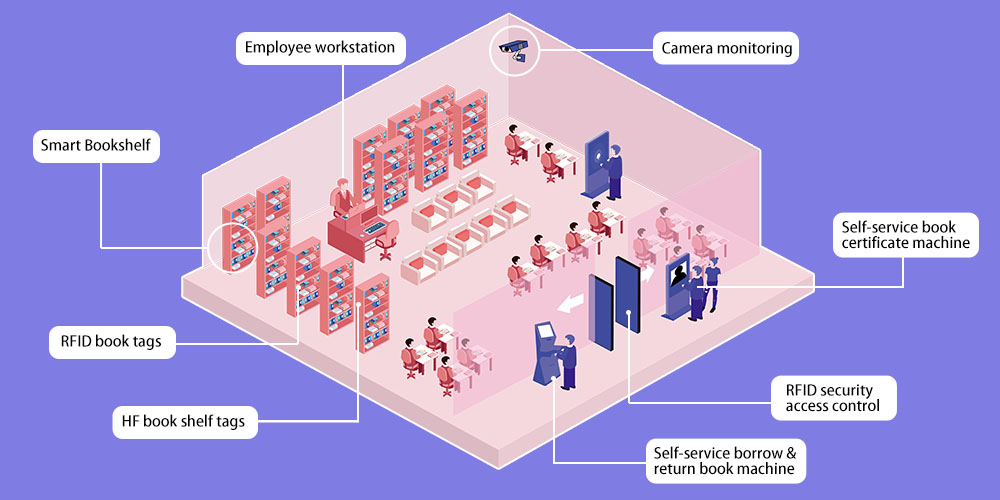In library applications, RFID tags can store a unique identifier for a book or CD and can be used for fast and efficient circulation processing and inventory management. According to incomplete statistics, 2% of libraries in the United States have installed RFID technology, and 8% of libraries in the world have begun to adopt RFID technology. In Asia, the RFID system has been put into use in Singapore, Thailand, Taiwan, and mainland China. Globally, the number of libraries using RFID is growing at a rate of 30% a year.
With the popularization of RFID technology, it has become an inevitable development trend for libraries to use the RFID smart system to replace the traditional management and anti-theft system based on barcode technology to build a new automatic and intelligent management mode.

What is RFID system in library?
The RFID Library system is based on RFID technology, combined with computer technology, programmable controller technology, and network communication technology to realize library foreground service and background management. It can realize the functions of library self-help borrowing and return, book inventory, bookshelves, book retrieval, book anti-theft, loan card management, library card issuance, collection information statistics, etc.
RFID library management system not only provides readers with more convenient and fast intelligent services such as borrowing and returning books, inquiry, etc., but also improves the management mode of the library, improves the work efficiency, reduces the labor intensity of managers, and provides a complete solution for the application field of the library.
The system includes a librarian workstation system, electronic label conversion system, self-service certificate system, self-service borrowing & return system, self-service book sorting system, collection inventory system, security access control system, intelligent navigation & retrieval system and self-service library and other functional subsystems.

Why do libraries use RFID technology?
The emergence of RFID technology improves the speed of data collection, especially realizes fast, efficient, and safe information reading and storage in the process of movement, and has the unique identity of the information carrier. These characteristics determine that RFID technology has a wide application in the field of the library. Compared with the traditional barcode system, the RFID library management system has many advantages.
Comparison between RFID Tag and Barcode for library
| Item | RFID Tag | Barcode |
| Read multiple goals at once | √ | × |
| Read moving targets | √ | × |
| Can be written | √ | × |
| Whether laser scanning is required | × | √ |
| Service life (100000 times) | √ | √ |
| Harsh environment use | √ | × |
| Waterproof | √ | × |
| Built-in anti-theft identification function | √ | × |
| Collection tool | √ | × |
| Mobile counting function | √ | × |
| Self-help multi-book borrowing & returning system | √ | × |
| Self-help book return system | √ | √ |
| Automatic sorting system | √ | √ |
1、Simplify the process of borrowing and returning books
The process of borrowing and returning books with bar code is tedious and inefficient. Moreover, because the bar code is easy to wear or fall off, it affects the efficiency of borrowing and returning books as well as readers’ satisfaction with the library. RFID can randomly place many books in the reading and writing range of the reader to achieve lending or return at one time, which is several times more efficient than the barcode, and the efficiency is greatly improved.
2、Automation of book inventory
Relying on manual book inventory work, especially the inventory of books on the bookshelf, is too large and inefficient. RFID has the ability of non-contact, long-distance, fast reading, and multiple labels at a time, making the inventory work fast, accurate, and efficient. Moreover, using RFID technology, it is easy to find books that are not on the shelf or misplaced on the shelf. Staff can easily carry out the inventory of books, greatly saving manual work and material resources.
3、Optimize lending management
The traditional library anti-theft system is still isolated. When it is found that the book is lost, the information of the book cannot be recorded concurrently, which has a great impact on the daily inventory. The RFID system improves the current management system, connects the omission prevention system with the book circulation management system, and records the history of each book in and out of the library, to match the history of borrowing and returning books.
4、Improve the satisfaction of readers
The traditional library management system is inefficient in borrowing and returning books. You may have to wait for a long time, and when it comes to your turn, you may encounter some problems, such as information reading error, bar code cannot be read, etc. This is a terrible reading experience. However, the RFID library management system will give you a better experience that you do not need to wait in line, more convenient and intelligent.
5、Change the service mode of the library
The application of RFID technology makes the unmanned library possible, and the library can be fully open 24 hours a day in a real sense. At the same time, RFID liberates a large of personnel occupied by the circulation department, making the business process reengineering of the library necessary and feasible; Libraries will shift from collection-centered to reader-centered, and the services provided to readers will be diversified, advanced and humanized.
6、Realize overall digital management
In addition to books, CD-ROMs, and collection treasures, other aspects of library management also need to be digitized, for example, the management of readers, administrative management, small consumption, and so on. The traditional management is time-consuming and inefficient, and it is very inconvenient for readers and librarians. Through RFID technology, these links can be digitized effectively to realize the overall digital management of the library.
What are the RFID tags used in the library?
RFID animal electronic tags can store all kinds of animal information and have a 64-bit (8-byte) identification code strictly following the ISO, which is unique in the world. In animal management, RFID tags are usually designed and packaged into different types of animal objects for tracking and recognition. Animal RFID tags are roughly divided into neck collar type, ear tag, injection type, and pill type electronic tags, and so on.

This book label is ultra-high frequency tag, with ultra-high concealment, can be affixed to the spine, not easy to tear, not easy to damage. Moreover, it has the advantages of high recognition rate, no missing reading when multiple files are densely stacked, excellent anti-magnetic stripe interference performance, and this RFID library tag commonly uses Alien H3 chip with stable performance.

This RFID book sticker works on 13.56MHz, and it usually is placed on the book cover. It has strong glue on the back that it is not easy to fall off after pasting, and this library sticker can be printed through the label printer. It is an economical solution for book identification and tracking that makes library management more intelligent and convenient.

RFID bookshelf tag is generally a PCB anti-metal tag, which is specially designed for complex environments such as metal. It has the characteristics of long reading distance, high sensitivity, and easy installation, especially suitable for all kinds of metal environment. It can be affixed to the metal bookshelf to facilitate the inventory and management of books.

The RFID library card is an RFID card. It can be customized into any pattern according to the requirements of your library. Compared with ordinary library cards, it has a built-in RFID chip, which is usually high-frequency. When entering or leaving the library, you can be identified without showing your library card, improving efficiency, and reducing queues.
Conclusion
With the development of RFID technology, it has become an inevitable development trend for libraries to use the RFID system to replace the traditional management system to build a new automatic and intelligent management mode. At present, more than 5000 libraries in the world are using the RFID system, and the number of new libraries introducing the RFID system is still growing. RFID technology will also lead to great changes in the pre-existing management and service patter of the library, injecting new vitality into the future development of the library.
If you have any questions about RFID library tags or others, feel free to contact us.
Relevant articles
- Proximity Card: A Cost-effective Solution for Access Control
- RFID Animal Tracking and Identification
- RFID for Access Control Management You Would Like to Know
- The Ultimate Guide to Know RFID Asset Management
- RFID for Laundry: How it works? What the benefits?
- Deeply Dug: RFID for Tracking
- RFID Helps to Identify and Protect Motorcycles
- 9 Common Applications RFID in Hospitals
- How does RFID revolutionize manufacturing?
- How RFID Technology Changes the Garment Industry?







I was recommended this website by my cousin I am not sure whether this post is written by him as nobody else know such detailed about my trouble You are amazing Thanks
You have shown the difference between RFID and Barcode technology very easily that gives the libraries an idea why they need to take the transition from barcode to RFID in libraries.